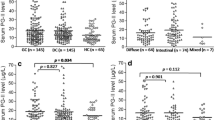Abstract
The role of genetics in the susceptibility to functional dyspepsia (FD) is not well established. Recently, two different associations were reported between FD and G-protein beta3 (GNB3) subunit gene polymorphism. We aim to clarify the association between GNB3 protein C825T polymorphism and dyspepsia in the Japanese population. Eight-nine dyspeptics and 94 nondyspeptic subjects enrolled in this study. All subjects underwent gastroscopy and patients with significant upper gastrointestinal findings were excluded. Other diseases were also excluded by face-to-face history and physical examination. GNB3 protein C825T polymorphisms were determined by polymerase chain reaction-restriction fragment-length polymorphism. H. pylori infection status was examined by histology or antibody against H. pylori. Nonsignificant correlation was found between GNB3 protein homozygous 825T and unexplained dyspepsia (OR = 1.65, 95% CI: 0.87–3.13). However, among H. pylori-negative subjects, homozygous GNB3 protein 825T significantly increased the risk of dyspepsia (16.7% versus 40.5%; CC versus TT; OR = 5.10, 95% CI: 1.21–21.43, CC versus others; OR = 3.40, 95% CI: 1.16–9.93, respectively). This significant association remained after logistic regression analysis with adjustment for sex and age (CC versus TT; OR = 5.73, 95% CI: 1.27–25.82, CC versus others; OR = 3.08, 95% CI: 1.02–9.25). No significant correlation was found between GNB3 polymorphism and any dyspeptic symptoms. Our data suggest that the homozygous 825T allele of GNB3 protein is associated with dyspepsia in the H. pylori-negative Japanese population. The role of genetics in the development of dyspepsia needs further evaluation.
Similar content being viewed by others
References
Locke GR 3rd (1998) Prevalence, incidence and natural history of dyspepsia and functional dyspepsia. Baillieres Clin Gastroenterol 123:435–442
Talley NJ, Zinsmeister AR, Schleck CD, Melton LJ 3rd (1992) Dyspepsia and dyspepsia subgroups: a population-based study. Gastroenterology 102:1259–1268
Talley NJ, Stanghellini V, Heading RC, Koch KL, Malagelada JR, Tytgat GN (1998) Functional gastroduodenal disorders. Gut 45 (Suppl 2):II37–42
Stanghellini V, Tosetti C, Paternico A, Barbara G, Morselli Labate AM, Monetti N, Marengo M, Corinaldesi R (1996) Risk indicators of delayed gastric emptying of solids in patients with functional dyspepsia. Gastroenterology 110:1036–1042
Tack J, Piessevaux H, Coulie B, Caenepeel P, Janssens J (1998) Role of impaired gastric accommodation to a meal in functional dyspepsia. Gastroenterology 115:1346–1352
Holtmann G, Goebell H, Jockenhoevel F, Talley NJ (1998) Altered vagal and intestinal mechanosensory function in chronic unexplained dyspepsia. Gut 42:501–506
Coffin B, Azpiroz F, Malagelada JR (1994) Selective gastric hypersensitivity and reflex hyporeactivity in functional dyspepsia. Gastroenterology 107:1345–1351
Drossman DA, Makee DC, Sandler RS, Mitchell GM, Cramer EM, Loweman BC, Burger AL (1988) Psychological factors in the irritable bowel syndrome. A multivariate study of patients and nonpatients with irritable bowel syndrome. Gastroenterology 95:701–708
Drossman DA (1990) Personality and psychological factors in the irritable bowel syndrome. Gastroenterol Clin Biol 14:49C–53C
Locke GR 3rd, Zinsmeister AR, Talley NJ, Fett SL, Melton LJ 3rd (2000) Familial association in adults with functional gastrointestinal disorders. Mayo Clin Proc 75:907–912
Gollasch M, Kleuss C, Hescheler J, Wittig B, Schultz G (1993) Gi2 and protein kinase C are required for thyrotropin-releasing hormone-induced stimulation of voltage-dependent Ca2+ channels in rat pituitary GH3 cells. Proc Natl Acad Sci USA 90:6265–6269
Kleuss C, Hescheler J, Ewel C, Rosenthal W, Schultz G, Wittig B (1991) Assignment of G-protein subtypes to specific receptors inducing inhibition of calcium currents. Nature 353:43–48
Kleuss C, Scherubl H, Hescheler J, Schultz G, Wittig B (1992) Different beta-subunits determine G-protein interaction with transmembrane receptors. Nature 358:424–426
Kleuss C, Scherubl H, Hescheler J, Schultz G, Wittig B (1993) Selectivity in signal transduction determined by gamma subunits of heterotrimeric G proteins. Science 259:832–834
Baumgart D, Naber C, Haude M, Oldenburg O, Erbel R, Heusch G, Siffert W (1999) G protein beta3 subunit 825T allele and enhanced coronary vasoconstriction on alpha(2)-adrenoceptor activation. Circ Res 85:965–969
Hegele R, Anderson C, Young T, Connelly P (1999) G-protein B3 subunit gene splice variant and body fat distribution in Nunavut Inuit. Genome Res 9:972–977
Kato N, Sugiyama T, Morita H, Kurihara H, Yamori Y, Yazaki Y (1998) G protein ß3 subunit variant and essential hypertension in Japanese. Hypertension 32:935–938
Klintschar M, Stiller D, Schwaiger P, Kleiber M (2005) DNA polymorphisms in the tyrosine hydroxylase and GNB3 genes: association with unexpected death from acute myocardial infarction and increased heart weight. Forensic Sci Int 153:142–146
Morrison AC, Doris PA, Folsom AR, Nieto FJ, Boerwinkle E (2001) Atherosclerosis risk in communities study. G-protein beta3 subunit and alpha-adducin polymorphisms and risk of subclinical and clinical stroke. Stroke 32(4):822–829
Zill P, Baghai TC, Zwanzger P, Schule C, Minov C, Riedel M, Neumeier K, Rupprecht R, Bondy B (2000) Evidence for an association between a G-protein beta3-gene variant with depression and response to antidepressant treatment. Neuroreport 11:1893–1897
Holtmann G, Siffert W, Haag S, Mueller N, Langkafel M, Senf W, Zotz R, Talley NJ (2004) G-protein beta 3 subunit 825 CC genotype is associated with unexplained (functional) dyspepsia. Gastroenterology 126:971–979
Camilleri CE, Carlson PJ, Camilleri M, Castillo EJ, Locke GR 3rd, Geno DM, Stephens DA, Zinsmeister AR, Urrutia R (2006) A study of candidate genotypes associated with dyspepsia in a US community. Am J Gastroenterol 101:581–592
Siffert W, Rosskopf D, Siffert G, Busch S, Moritz A, Erbel R, Sharma AM, Ritz E, Wichmann HE, Jakobs KH, Horsthemke B (1998) Association of a human G-protein β3 subunit variant with hypertension. Nat Genet 8:45–48
Kapadia CR (2003) Gastric atrophy, metaplasia, and dysplasia: a clinical perspective. J Clin Gastroenterol 36(5 Suppl):S29–36
Lee KJ, Vos R, Janssens J, Tack J (2004) Influence of duodenal acidification on the sensorimotor function of the proximal stomach in humans. Am J Physiol Gastrointest Liver Physiol 286:G278–G284
Schwartz MP, Samsom M, Smout AJ (2001) Chemospecific alterations in duodenal perception and motor response in functional dyspepsia. Am J Gastroenterol. 96:2596–2602
Author information
Authors and Affiliations
Corresponding author
Rights and permissions
About this article
Cite this article
Tahara, T., Arisawa, T., Shibata, T. et al. Homozygous 825T Allele of the GNB3 Protein Influences the Susceptibility of Japanese to Dyspepsia. Dig Dis Sci 53, 642–646 (2008). https://doi.org/10.1007/s10620-007-9923-0
Received:
Accepted:
Published:
Issue Date:
DOI: https://doi.org/10.1007/s10620-007-9923-0




